Nikon F5
Rumours of the F5 have abounded for quite a while now but Nikon have done
a quite incredible job of keeping the specifications and styling of their
new flagship secret right up until the official launch. A few months ago I
did my own bit for the rumour mill by suggesting what the F5 should/could
be while writing about the F90X. I believe a few individuals thought that
we were privy to some inside information of the impending F5 - not so!
However, I'm glad to say that Nikon must have been listening eagerly as
the F5 is indeed quite close to my suggestion. Imagine that, in the space
of just a couple of months their engineers had managed to knock together
exactly what little ol' me had asked them for...
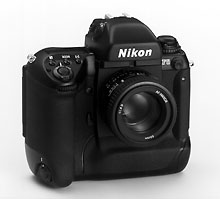 On a boat on the Baltic last month the press were finally permitted to get
their grubby paws on the latest addition to the most respected line of
cameras in the business. And the F5 certainly does not let down its
forebears at all, having all those F series hallmarks that we had feared
might be sacrificed on the altar of amateur appeal. The features that sets
the F series apart from the likes of the F301-801 and F50-90 (yes, yes
they start with an "F" too but you know what I mean) are
On a boat on the Baltic last month the press were finally permitted to get
their grubby paws on the latest addition to the most respected line of
cameras in the business. And the F5 certainly does not let down its
forebears at all, having all those F series hallmarks that we had feared
might be sacrificed on the altar of amateur appeal. The features that sets
the F series apart from the likes of the F301-801 and F50-90 (yes, yes
they start with an "F" too but you know what I mean) are
- a) that the
viewfinder will show you a true 100% of the image area
- b) there are a
choice of interchangeable viewfinders
- c) the build quality is
considerably more rugged than the "amateur" models.
The F5 remains true to
all of these while still more than keeping up with the rest of the field
in terms of features and performance.
Advance
Sports photographers will be delighted with the integral motordrive which
is capable of speeds of 8fps when fitted with the optional Nickel Metal
Hydride battery. Even with the normal complement of eight AA alkaline
cells a maximum speed of 7.4fps is achieved. "Pretty fast but I've heard
of better!", I hear you say - but not with full AF tracking you ain't...
With these fast and fully usable advance speeds rewind speed becomes more
and more relevant and this is why the F5 is capable of a blistering 4
second (6 secs with AA's) rewind time for a 36 exposure roll. If silence
is a priority you can still rewind manually and there is a silent 1fps
advance mode. Having said this the F5 is surprisingly quiet and any of its
modes. Those who find the prospect of zipping through 36 exposures in
under five seconds a little frightening (considering the price of film
these days) will be relieved to know that there is a more controllable 3
fps mode and that even the top speeds can be reduced by using some of the
custom settings.
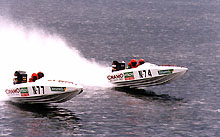
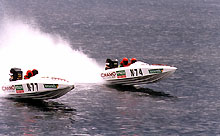
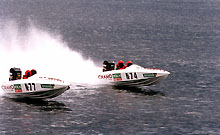
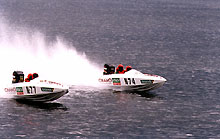 Oh no! It's those speedboats again! Sorry, but it does show the ability of
the F5 to maintain full autofocus tracking at 8fps. In a series of eight
frames I had a 100% hit-rate when trusting the camera on full autofocus.
Oh no! It's those speedboats again! Sorry, but it does show the ability of
the F5 to maintain full autofocus tracking at 8fps. In a series of eight
frames I had a 100% hit-rate when trusting the camera on full autofocus.
AF
The autofocus system employs five sensors which, between them, cover
almost the whole frame and are represented on the screen by five small
squares in a St George's Cross pattern. The usual choice of Spot or Wide
focusing is available. Alternatively individual areas can be selected via
a thumbpad on the back - presumably this will be amply familiar to the new
generation of photographers who have grown up with Nintento and Sega
instead of train sets and tin soldiers. The square for the chosen zone
increases in density and is also indicated by red LED markers off the
frames area. If this isn't enough there is also an extra "smart" mode
which will give preference to a selected area but will follow the subject
if it moves into another part of the frame. This last mode may sound
complex but it in use is (to steal from computer jargon) "invisible" to
the user. If you find the five focus zones on the screen distracting it is
possible to buy an unmarked screen and use the top plate and LEDs to keep
track of the selected modes and zones.
The most important aspect of the focusing system is the ability to allow
full AF tracking at the 7.4/8fps maximum drive speeds - hitherto unheard
of. The system is also programmed to ignore objects momentarily passing
between the camera and subject - such as a lamppost, tree or wandering
spectator - without attempting to refocus.
This new AF system will offer its peak performance with the new Silent
Wave 'S' series Nikkors but will also offer improved performance with
current 'D' series lenses. Naturally it is compatible with all older
Nikkors with the usual losses of functionality with the older examples.
Metering
Metering on the F5 is undoubtably the most versatile and sophisticated in
the Solar System. Users have the now familiar choice of three modes;
Matrix, Centre Weighted and Spot. However each of these modes is more
advanced and flexible before. The Matrix mode takes its reading from a
staggering 1005 pixel matrix and also takes colour content into
consideration along with feedback from the AF system (if using 'D' or the
new 'S' series lenses). This information is then referred to an internal
database of over 30,000 actual (and hopefully correctly exposed)
photographs and only then is the appropriate exposure decided upon. Of
course it takes around two minutes to work all this out. You didn't
believe me there, did you? It's instant, of course, but the rest is true.
The Spot mode covers a tight 4mm pattern which can, if required, "tied" to
the AF sensor in use - and hence control with the "Nintendo pad" on the
camera back.
The Centre Weighted mode (now rarely used by many photographers)takes on a
whole new lease of life on the F5, as it has a choice of four patterns
(set on the custom menu) which cover either 8mm, 12mm, 15mm or 20mm areas
with the traditional 75/25% balance. If you link your F5 to a Mac or PC -
yep, it does that too, replacing the questionable Sharp organiser
compatibility of the F90 - you can adjust the pattern even further, as
well as accessing various other features and downloading internally stored
exposure data.
Metering range is a fairly standard EV0-20 in Matrix and Centre Weighted
and EV2-20 in Spot mode.
The shutter runs up to 1/8000 and offers flash sync of 1/250, or 1/300 at
reduced flash output. Full compatibility with SB-26 and SB-27 flash units
is maintained including the 5 segment TTL flash metering. One interesting
feature of the shutter is that it is a self diagnostic unit which
constantly checks and recalibrates itself throughout its life. At this
juncture camera repair engineers are permitted to swear out loud at Nikon
over the resultant loss of business.
A configurable auto bracketing feature is at last included, and when
combined with the fast advance rate, will be welcomed by many.
Design
I was delighted to see that no compromises have been made in build quality
and weatherproofing. A floating mechanism within an aluminium alloy shell
provides an ideal compromise between strength, lightness and noise
reduction. The prism finder is housed in titanium for much the same
reasons. Sealing against the elements is a step ahead of even the F4 - and
presumably light years ahead of the F90 series.
Ergonomics are, in my opinion, better than any other competing product.
The F5 is better balanced than the F4 and benefits from being slightly
more compact and marginally lighter.
One major departure from traditional Nikon design is the addition of a
front "secondary" control dial which can be used to adjust the aperture -
although purists can still use the old fashioned method.
Conclusion
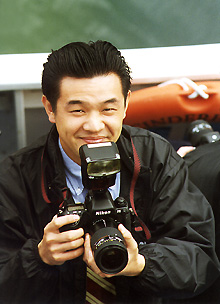 So, all in all, I have to say my guesstimate wasn't too far off the mark -
"...a reworked F4 with the advanced features of the F90X and, with any luck,
an autobracketing feature. And if that doesn't create the perfect
professional 35mm SLR, I don't know what will." Well as the F5 exceeds
even those expectations, I might be expected to place that very crown on
its titanium top. But, I'll tell you what, let's reserve final judgement
until we've given it a proper going over. Watch this space...
So, all in all, I have to say my guesstimate wasn't too far off the mark -
"...a reworked F4 with the advanced features of the F90X and, with any luck,
an autobracketing feature. And if that doesn't create the perfect
professional 35mm SLR, I don't know what will." Well as the F5 exceeds
even those expectations, I might be expected to place that very crown on
its titanium top. But, I'll tell you what, let's reserve final judgement
until we've given it a proper going over. Watch this space...
Return to Photon August 96 contents
 On a boat on the Baltic last month the press were finally permitted to get
their grubby paws on the latest addition to the most respected line of
cameras in the business. And the F5 certainly does not let down its
forebears at all, having all those F series hallmarks that we had feared
might be sacrificed on the altar of amateur appeal. The features that sets
the F series apart from the likes of the F301-801 and F50-90 (yes, yes
they start with an "F" too but you know what I mean) are
On a boat on the Baltic last month the press were finally permitted to get
their grubby paws on the latest addition to the most respected line of
cameras in the business. And the F5 certainly does not let down its
forebears at all, having all those F series hallmarks that we had feared
might be sacrificed on the altar of amateur appeal. The features that sets
the F series apart from the likes of the F301-801 and F50-90 (yes, yes
they start with an "F" too but you know what I mean) are



 So, all in all, I have to say my guesstimate wasn't too far off the mark -
"...a reworked F4 with the advanced features of the F90X and, with any luck,
an autobracketing feature. And if that doesn't create the perfect
professional 35mm SLR, I don't know what will." Well as the F5 exceeds
even those expectations, I might be expected to place that very crown on
its titanium top. But, I'll tell you what, let's reserve final judgement
until we've given it a proper going over. Watch this space...
So, all in all, I have to say my guesstimate wasn't too far off the mark -
"...a reworked F4 with the advanced features of the F90X and, with any luck,
an autobracketing feature. And if that doesn't create the perfect
professional 35mm SLR, I don't know what will." Well as the F5 exceeds
even those expectations, I might be expected to place that very crown on
its titanium top. But, I'll tell you what, let's reserve final judgement
until we've given it a proper going over. Watch this space...